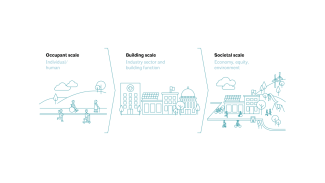Architectural research
AIA calls for and supports architectural research across the three scales of influence: Individual/human, industry sector and building function, and community and societal.

Architectural research topics
While we have organized work into these scales (occupant, building, and community), we recognize and appreciate how much more expansive some areas of inquiry are, as well as the crossover and intersections among the different scales and disciplines.
Occupant scale
Individual/human
At the heart of our built environment are the occupants of buildings, whether they be homes, offices, schools, or other building types. According to the US Environmental Protection Agency (EPA), Americans spend 87% of their time inside buildings, making the built environment they inhabit critical.
There are three research themes at this scale. While these themes overlap, we believe they constitute different applications and therefore are worth separate delineation.
- Human behavior: The understanding of how a building design can improve human performance, including the metrics, measures, and methods necessary in order to evaluate the impact of buildings on human experience.
- Health and well-being: The ways a building influences the occupants’ health. This includes the occupants’ safety, as well as their physical and mental health status.
- Neuroscience: The understanding of how the human brain reacts to stimulus and its impact on behavior and cognitive function.
Building scale
Building type, performance, delivery
Buildings are significant contributors to GDP, yet the buildings’ design, systems, materials, products, and physical construction also have tremendous impact on the environment and our natural resources. Buildings are the heart of many communities, and these structures act as incubators for new technologies and innovations.
There are four research themes at this scale. They often overlap but have research that is distinct enough to be noted independently.
- Building performance: Buildings consume large amounts of resources and themselves have tremendous impact. This study area covers the science of buildings, including efficiency, high performance outcomes, resilience, and impact on the environment.
- Technology: Understanding use, adoption, advantages, etc., to using new technology to create and operate a building as well as technologies used in design, practice, and construction. We also encourage an understanding of larger technology trends (e.g., internet of things, robotics, big data, 5D printing, autonomous vehicles), which might impact the work of architects.
- Materials: Improving buildings' function and form, new materials, materials impact, transparency, sustainability, etc.
- Project delivery and processes: Examination of the way a project is delivered includes formal project delivery systems as well as construction methodologies, risk allocation, relationships between clients and partners, building codes, permitting, etc.
Community scale
Economy, equity, environment
The architectural profession and the buildings they design are also part of the fabric of life, whether that be a rural community, small town, or urban landscape. The architect then is a part of the solution to problems that are larger than any individual building. This Research Agenda recognizes the importance of the architect’s role and interventions that the architect can make to help be part of the solution to larger social and societal issues.
There are a number of social issues the architectural profession, through design, can influence, but we focus on four areas that we believe architects are uniquely positioned to lead.
- Urbanism: Influence of the built environment in shaping human potential in the context of rapidly accelerating urbanism.
- Resilience & adaptation: Study of resilience, adaptation, reuse, urban and community planning, and other design interventions that can mitigate the effects of disasters.
- Climate change: Design interventions that reduce the impact of the built environment on climate change, including mitigation, decarbonization, preservation, materials innovation, etc.
- Community: Understanding use of design, community engagement, and culture to improve equity and quality of life for all.
The AIA Upjohn Research Initiative and the AIA College of Fellows Latrobe Prize award funding to research that enhances the value of design and professional practice knowledge.
AIA has identified areas of research need and is calling for expanding investment in architectural research. Our agenda includes prioritization within the architecture culture and the continued dissemination and exchange of findings.
